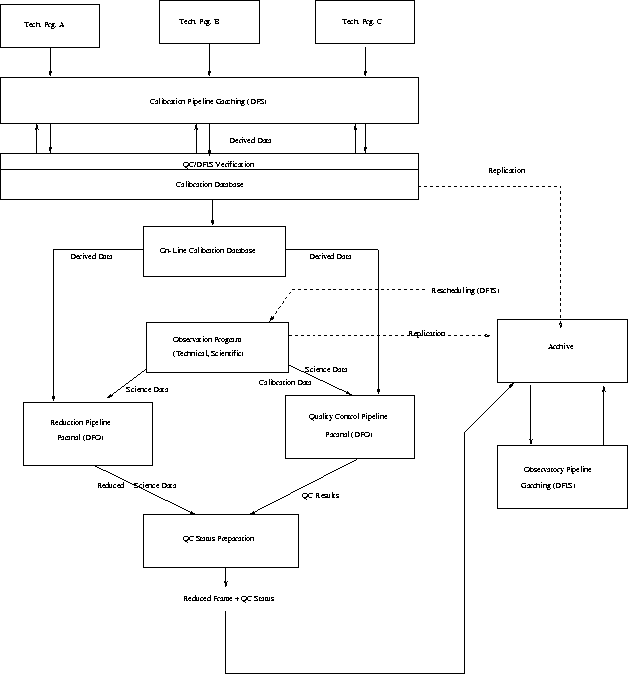
Next: The ESO VLT CCD Detectors Software
Previous: Physical Modeling of Scientific Instruments
Up: Instrument-Specific Software
Table of Contents - Index - PS reprint - PDF reprint
P. Ballester, K. Banse, and P. Grosbøl
European Southern Observatory,
Karl-Schwarzschildstr. 2,
D-85748 Garching,
Germany
The general framework for handling VLT data operations and processing is the Data Flow System, which is composed of a number of subsystems and foundation layers. The Data Flow System (Grosbøl & Peron 1997) includes all services involved, from observation preparation to data analysis. In this paper we present the pipeline and quality control parts of the system.
For pipeline processing, the header structure of the data is interpreted by a Data Organizer to associate the individual Frames, identify Reduction Recipes, and create Reduction Blocks. There will be four kinds of pipeline procedures:

Quality Control verifies the conditions and the results with which the Reduction Pipeline performs its task. To this end, the Quality Control subsystem verifies the instrumental and observational conditions and compares them to the specifications of the Reduction Pipeline. In addition, Quality Control performs some verification of the data processed by the Pipeline. Instrument performance, observing conditions, and pipeline results contribute to the estimation of a Quality Status attached to each Reduced Frame.
The following levels of testing will be performed in the context of Quality Control. These tasks are presented in a sequence corresponding to the expected level of automation: (i) completion testing, (ii) routine testing: detector, calibration lamps, arc lines, (iii) instrument function testing: focus, instrument response, and (iv) specific testing: scattered light, non-linearities. Some of these tasks will be implemented in the Quality Control pipeline and be executed during observations. Others will be implemented as interactive procedures.
An important aspect of Quality Control will be the production and maintenance of instrument models for the purpose of exposure time calculation and instrument control.
The development of an instrument model framework consists of a close collaboration between the ESO Data Management Division (DMD) and Space Telescope European Coordinating Facility (ST/ECF). The VLT and the HST facilities have quite similar demands, because both astronomical observatories are committed to rapid dissemination of data from a variety of instruments to the world-wide community at a large.
One of the VLT instruments under construction is the high resolution echelle spectrograph UVES; first light is planned for 1999. The DMD model for this instrument now succeeds in predicting the geometrical aspects of observational data to better than one resolution element (pixel) of the detector. In parallel, the ST/ECF has produced a computer model for the low-resolution Faint Object Spectrograph (FOS) on HST (Rosa 1995). This software is optimized for simulating internally scattered light, which is a serious nuisance for observations of faint targets.
A direct result of such models is exposure time calculators, which observers can use to estimate the length of each exposure when preparing an observing program. To allow wide access by the scientific community to such tools, the software for these calculators is being made available on the Internet.
The success of these first modeling experiments has led to the definition of a common framework for the development of such models, and to the creation of a versatile software package and associated database. Within this environment, a slight modification of the UVES software was efficiently re-used to model an existing high-resolution spectrograph-CASPEC at the ESO 3.6-metre telescope-and is currently being transformed into a model for the STIS spectrograph on HST.
The next steps will be to provide models for all those instruments that will become operational on the VLT and the HST in the coming years, and to study further the impact of the improved calibrations on new data analysis techniques.
Grosbøl, P., & Peron, M. 1997, this volume
Rosa, M. R. 1995, in Calibrating and Understanding HST and VLT instruments, ed. P. Benvenuti, ESO/ST-ECF Workshop, ESO, 43
Next: The ESO VLT CCD Detectors Software
Previous: Physical Modeling of Scientific Instruments
Up: Instrument-Specific Software
Table of Contents - Index - PS reprint - PDF reprint